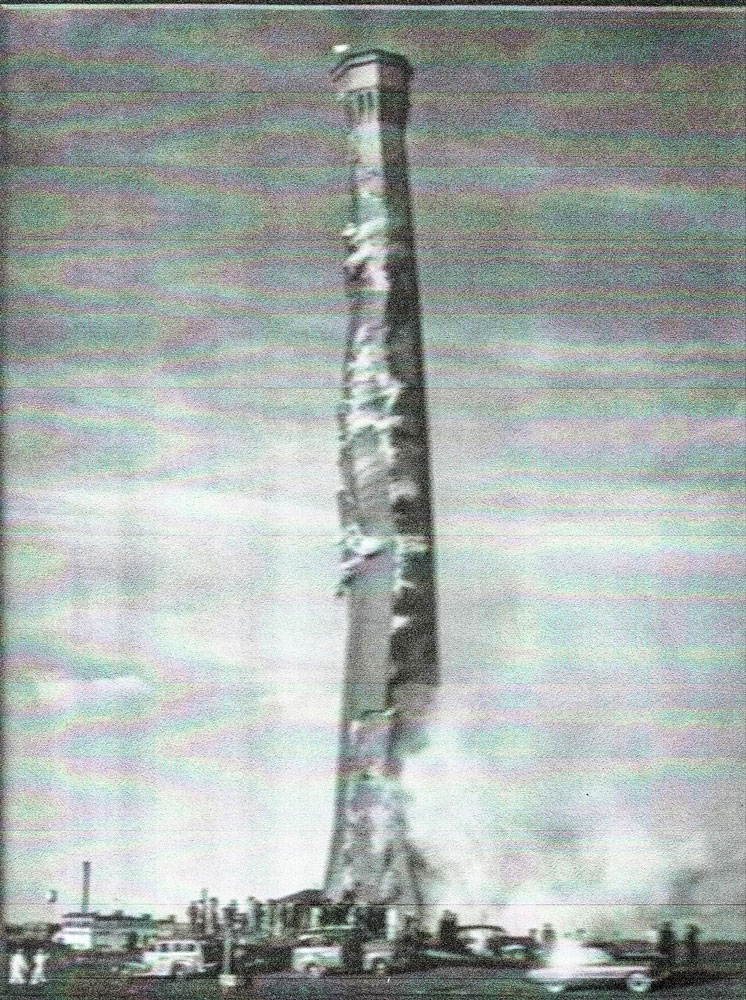Gus Nelson: One tough old bird
By Joe Gschwendtner; photo courtesy of Western History Section, DPL

Demolition of the Grant Smelter smokestack in 1950. It was replaced in 1952 with Denver Coliseum. The Denver Post estimated 250,000 watched its demolition. Gus Nelson (and others) devoted many years to building it in the late 1800s
Outliers make for legends. Bengt August (“Gus”) Nelson was one of them. Born in Falkenberg, Sweden in 1863, it was Gus’ destiny to become a great one. Great granddaughter Jo Nelson Bradford called him “a tough old bird.”
At 18, Gus took passage on a ship to America. After his first job in Philadelphia shipyards, he migrated to Colorado in 1884, working both at a Leadville smelter, and later on the Grant Smelter smokestack in Denver.
In 1893, he met and married Betty Johnson, 10 years his junior and a native of Vexio, Sweden.
His rise to greatness began as he proved his mettle and supervisory talent in Castle Rock quarries. A strapping fellow, Gus almost singlehandedly worked the O’Brien Quarry for two years. Rhyolite (lava stone) was typically found beneath 25-50 feet of overburden. Gus was an especially good powder man and knew how to pack the holes. Done right, one explosion could produce 100 tons of transportable rocks.
Businessman Jonathan Thomas approached Gus one day while visiting the O’Brien Quarry, inducing him to come north to the Santa Fe Quarry, abutting what is the south side of The Meadows community today.
Betty carried her weight by keeping a boarding house for his men. Discouraged early on by the low yield, Thomas would sweeten Gus’ wages to $4.50 an hour and a side deal on contracted stone. He would remain there for a decade when the industry eventually played out, concrete being seen as better material.
The Nelsons saved most of Gus’ wages hoping they could buy a ranch before the rhyolite ended its reign. A winning plan it was. With their first $4,000, Gus and Betty bought a ranch from a New Yorker named Chapin in 1904. Remaining several more years at the quarry, he moved to his “Thorsholm” ranch in Sedalia in1906.
After moving, he observed that many of his neighbors struggled with their own farm and ranch parcels. This was his opportunity. Gus proceeded to buy up failing properties around his own on the cheap. After adding the Waterhouse, Campbell, Miller and Cann homesteads to theirs, the Nelsons would come to own 2,408 acres.
The Nelsons grew a variety of crops, including wheat, corn, oats and hay. Gus also had 40 dairy cattle and 100 beef cattle. More than once, Gus had his cattle rustled, eight in one year being the record. He offered rich rewards for their return.
Gus would acquire an early version of the Ford Model T with which he fell in love. He once drove to California and back in it. He and Betty celebrated their Golden Anniversary in April 1943.
Two stories deal with Gus’ legendary toughness. Once, while watching weekend sandlot baseball in Sedalia, he was struck in the temple with a hot line drive. Knocked him out. When revived, he got up and watched the rest of the game as if nothing had happened. Then there was that 500-pound block of salt at a local mercantile. Told by the merchant, “If he could move it, he could have it.” Gus picked it up, put it on his wagon, and trotted away.
Wildcat Lore
As it turns out, The Connection serves residents of the Wildcat Mountains, a name pioneers and historians gave to the high country paralleling I-25 from Highlands Ranch and Lone Tree south to Castle Rock. Since the first territorial road (Daniels Park Road) bisected our mountains, there was no shortage of colorful characters parading through what are now private properties on the ridges of Douglas County. We bring these grizzled and gutsy settlers alive again, vividly sharing their stories of grit and achievement in these Castle Pines.